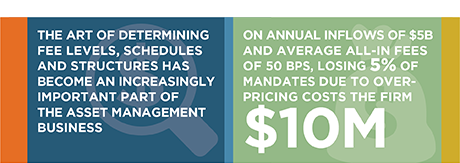
Fee compression is one of the biggest challenges facing institutional asset managers today. Institutional investors are focused on fees to a level never before seen in the industry. While in the recent past mandate pricing was almost an afterthought—often addressed at the conclusion of the sales process—today manager searches start with fee screening that immediately eliminates from consideration any manager with stated list prices outside an acceptable window. After that, institutional investors expect to negotiate discounts and customize fee schedules and structures.
As a result of these changes, the art of determining fee levels, schedules and structures has become an increasingly important part of the asset management business. In that respect, many managers place themselves at a competitive disadvantage by setting fees without having access to quality benchmark data that capture the many idiosyncrasies that influence pricing of institutional mandates. Managers that rely on top-line industry averages to benchmark fees—or worse, the
“in-depth knowledge” of their salespeople—risk mispricing to the upside or downside. This can result in millions of dollars in lost revenue and reduced profits—potentially fatal errors in today’s hypercompetitive marketplace.
In this Greenwich Report, we analyze the factors that have made fees a top priority for institutional investors and examine how the increased prominence of pricing is affecting the competition for institutional mandates and the businesses of institutional managers. We then demonstrate how managers can turn pricing into a competitive advantage by using more comprehensive and sophisticated industry data that accounts for variables that influence pricing—including product, vehicle, mandate size, geography, consultant participation, organization type, the investor’s status as an existing or new client, and past investment performance, among other contextual factors.

